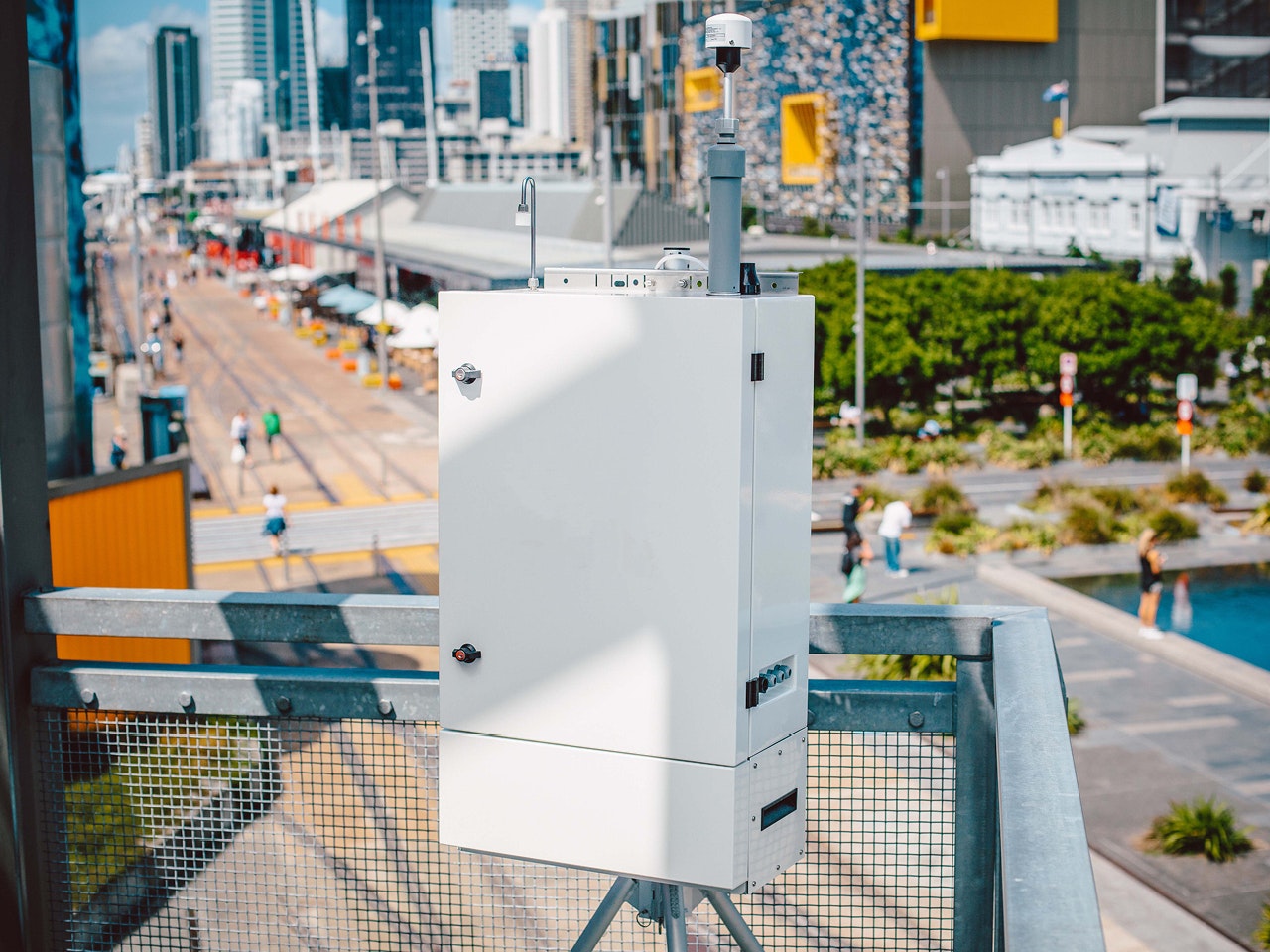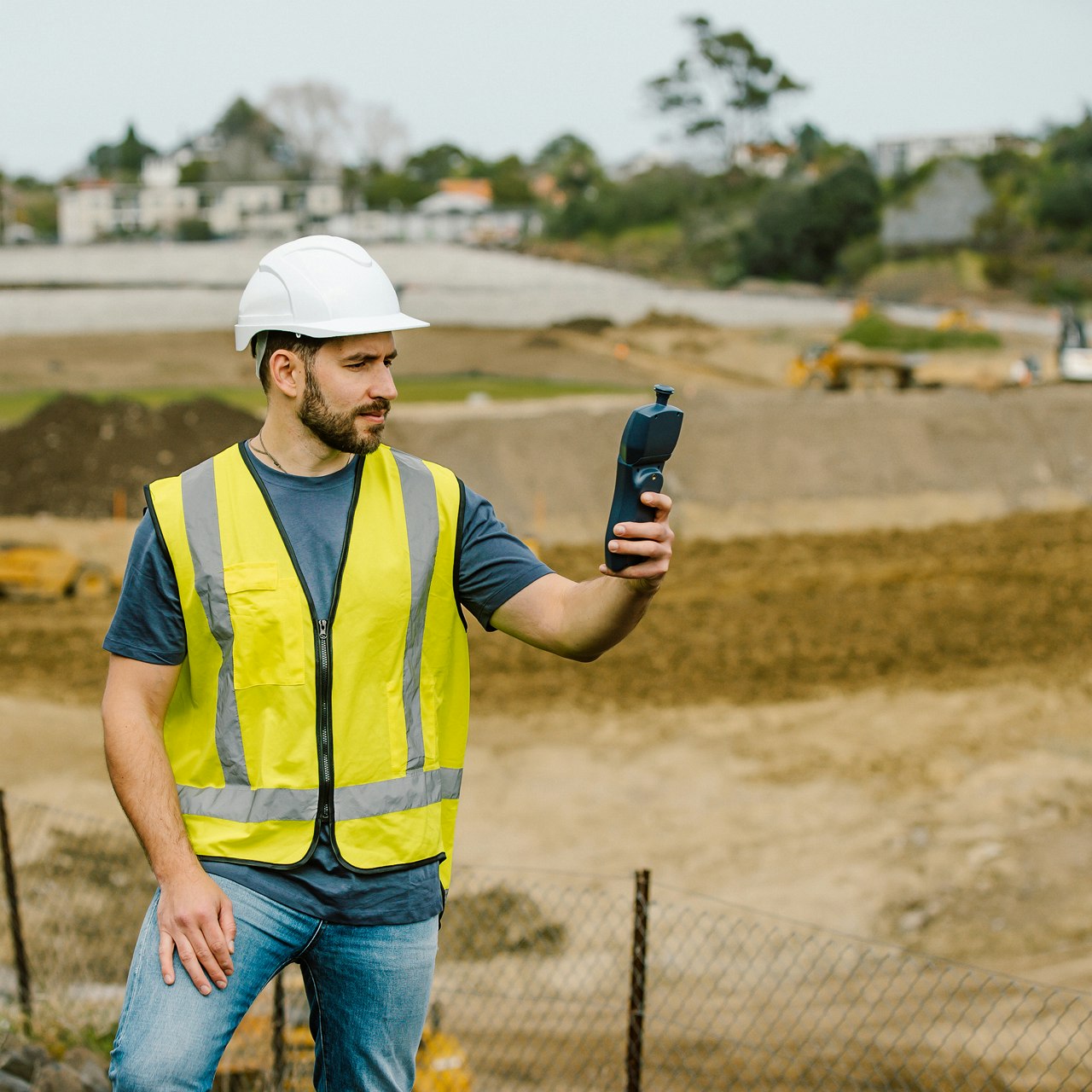Measurements
Ozone O3
Aeroqual designs and delivers monitors that measure ozone (O3). Choose from our perimeter, handheld or indoor fixed air monitoring range.
Here we cover ozone measurement principles, specifications and performance.
Overview of ozone
Ozone (O3) is one of six criteria air pollutants identified by the US EPA and is monitored extensively around the world by regulatory agencies.
Ozone is formed naturally in the stratosphere by the reaction of oxygen (O2) and UV light. O3 in the stratosphere absorbs harmful deep UV light and, protects the biosphere on the ground.
O3 can also be formed at ground level by a complex reaction between UV light, NOx, and volatile organic compounds (VOCs), which come from anthropogenic sources such as vehicles and industrial emissions. O3 at ground level is harmful to vegetation and humans which is why it is monitored.
Perimeter air quality monitors
The O3 analyzer module features in our perimeter air quality monitors: AQS 1 Air Quality Monitor and AQM 65 Monitoring Station.
Ozone module measurement principle
The sensor used in the ozone module is a Gas Sensitive Semiconductor (GSS) sensor manufactured by Aeroqual. The sensing material is a n-type semiconductor whose resistance increases when exposed to oxidizing gases such as O3. Selectivity towards O3 is achieved by careful control of the sensor material and operating temperature.
The module uses a patented design that creates two different flow states across the sensor: a zero-flow state and a measurement state. The sensor resistance is measured during both the zero and measurement states, and these values are used to calculate the O3 concentration using a proprietary algorithm approximately once per minute. The flow rate is determined by a flow control orifice on the exhaust side of the sensor and measured at the inlet to the sensor module (expected to be approximately 130 mL min-1).
Ozone module specifications and performance
Ozone Analyzer Module
Range (ppb)
0 - 500
Display Resolution (ppb)
0.1
Noise: Zero (ppb); Span (% of reading)
<1; 1%
Limit of Detection (ppb)
<1
Precision
2% of reading or 2 ppb
Linearity (% of FS)
1%
24 hr Drift: Zero (ppb); Span (% of FS)
1; 0.2%
Ozone field test results
An Aeroqual AQM 65 containing an O3 module was co-located in April 2022 at an air quality regulatory station in Riverside, Southern California and its data compared with reference data downloaded from the US EPA AirNow website. The O3 module produced an R2 of 0.99 and a mean absolute error (MAE) of 2.1 ppb. The low MAE value is indicative that the module has low zero and span drift.
Ozone module time series plot
Ozone module scatter plot of data with linear regression and coefficient of determination
Demonstration of equivalence
The total measurement uncertainty, based on the EU Guide to Demonstration of Equivalence, using an hourly limit value of 75 ppb, was calculated as 5.8%. Note that an expanded relative uncertainty of less than 15% is required for an O3 monitor to be considered regulatory grade. The O3 module meets this requirement.
Directive 2008/50/EC downloaded 10/02/2023 here.
Ozone module calibration and traceability
Just like a regulatory ozone analyzer using UV absorption, the ozone module can be field calibrated using standard calibration equipment. This ensures the module calibration is fully traceable to NIST primary standards.
O3 is not available in a gas cylinder due to its reactivity. The O3 module span calibration is achieved using a reference grade O3 source such as the 306 O3 calibrator from 2B Technologies. The module is zero calibrated using a zero air source such as the AirCal 1000 or AirCal 8000. The zero calibration step of the O3 module calibration takes approximately 15 minutes and the span calibration takes between 15 and 30 minutes.
Calibration frequency will be dependent on the user’s data quality objectives and Quality Assurance Project Plan (QAPP), but based on the low rate of field drift the recommended calibration frequency is 1-3 months.
Aeroqual can also offer its patented remote calibration procedure MOMA for this module which avoids the need for a site visit while also maintaining traceability to nearby regulatory air monitoring stations. See your Aeroqual representative for more information on this software tool.
Interferences
The Aeroqual ozone module is very specific towards O3, but other gases in the environment may also cause a response from the O3 sensor. These do not indicate a fault. These effects are part of the module behavior and should be considered when examining data.
The O3 module response to other ambient air pollutants is documented in the table below.
Pollutant
Test concentration / ppm
Typical module response / ppm
CO
1.0
No response
NO2
0.1
0.001
SO2
0.1
No response
H2S
0.1
-0.020
Ethylene
0.5
0.005
Ozone module expected lifetime
The ozone module contains a solenoid, which can fail occasionally. The lifetime of the solenoid is typically 2 to 3 years.
The GSS sensor does not contain materials which are consumed during its lifetime and O3 modules have been observed to provide high-quality readings in AQM 65s running continuously for up to 4 years in moderately polluted sites with regular instrument servicing. At sites with high pollutant levels and low service levels the lifetime can be reduced to as little as 1 year.
On average the lifetime of the O3 module is between 2 and 3 years.
Handheld air monitors and fixed indoor monitors
The ozone sensor heads feature in our handheld air quality monitors: Ranger, Series 500, and fixed indoor Series 900 air monitors.
Ozone sensor head measurement principle
Aeroqual offers two different sensor types for ozone measurement in our sensor head range:
- Gas sensitive semiconductor (GSS) sensor
- Gas sensitive electrochemical (GSE) sensor
The GSS sensor is manufactured by Aeroqual. The sensing material is an n-type semiconductor whose resistance increases when the sensing layer is exposed to an oxidizing gas such as ozone. Selectivity towards ozone is achieved through careful control of the sensor material and operating temperature. Like the ozone module, the GSS ozone sensor head goes through a zero cycle to improve accuracy and baseline stability. The sensor resistance is measured during the zero and measurement states, and these values are used to calculate the O3 concentration using a proprietary algorithm approximately once per minute. The GSS sensor head gives good accuracy, sensitivity, and stability at low ozone concentrations.
The GSE sensor head incorporates an electrochemical gas sensor. This sensor generates an electrical current in nA, which is proportional to the concentration of gas that comes in to contact with the sensor. The sensor current is converted to a voltage and this voltage is used to calculate the ozone concentration. The GSE sensor head has a faster response time than the GSS sensor head. The GSE sensor head can also be used across a wider concentration range. The GSS ozone sensor is affected by volatile organic compounds (VOCs) while the GSE sensors are cross sensitive to NO2 and Cl2.
The GSE sensor head is therefore more suitable for indoor applications, while the GSS sensor head is more suitable for outdoor applications.
The table below highlights the differences between the two sensors:
GSE (indoor)
GSS (outdoor)
Range
0-30 ppm (EOZ/EOZH)
0-0.5 ppm (OZS/OZU/OZL)
Detection Limit
0.01 ppm
0.001 ppm
Resolution
0.01 ppm
0.001 ppm
Response time
60 seconds
60-240 seconds
Zero
No
Yes
Main cross sensitivities
NO2 and Cl2
VOCs
GSS sensor head specifications
The table below contains the GSS sensor head specifications. These are suitable for outdoor applications and can be used on our Ranger and Series 500 products.
Sensor Code
OZS
OZU
OZL
Sensor Type
GSS
GSS
GSS
Range (ppm)
0-0.05
0-0.15
0-0.5
Detection Limit (ppm)
0.001
0.001
0.001
Accuracy of Factory Calibration
<±0.002 ppm
<±0.005 ppm
<±0.008 ppm 0-0.1 ppm
<±10% 0.1-0.5 ppm
Display Resolution (ppm)
0.001
0.001
0.001
Response Time (seconds)
240
60
60
GSE sensor head specifications
The table below contains the GSE sensor head specifications. These are suitable for indoor applications and can be used on our Ranger, Series 500, and Series 900 products.
Sensor code
EOZ
EOZH
Sensor type
GSE
GSE
Range (ppm)
0-10
0-30
Detection limit (ppm)
0.01
0.01
Accuracy of factory calibration
<±0.01 ppm + 7.5%
<±0.05 ppm + 10%
Display resolution (ppm)
0.01
0.01
Response time (seconds)
60
60
Sensor head field results
The ozone OZU GSS sensor head was evaluated by the South Coast Air Quality Monitoring District (SC AQMD) as part of their AQ-SPEC program. Three S500 bases with OZU sensor heads were deployed at the SC AQMD monitoring site in Rubidoux, Southern California. The R2 value was greater than 0.85 for all three units. You can view the full results here.
Ozone sensor head time series 8-hours
Ozone sensor head time series 24-hours
Products that measure ozone
The following products measure ozone, as well as particulate matter and gaseous pollutants in real-time.
Articles
Case Study - Brownfield Redevelopment
Devil's Gate Reservoir Restoration Project
Blog - Remediation
Perimeter Air Monitoring Plan Requirements – What All Site Remediators Need to Know
Blog - Remediation
Producing Defensible Data: The Importance of Keeping Calibration Certificates Up to Date
Inquire about our ozone products
Our ozone advanced monitoring systems deliver hyper-local data and real-time alerts, giving you actionable data to make the decisions that matter.












